The Bathroom for FIR Sauna
Introduction:
I was first introduced to the potential health benefits of alkaline ionized water and far infrared (FIR) devices in 1992 in the book 'Reverse Aging' by Sang Wang. For those that may not be familiar with the potential health benefits of Far Infrared I suggest that you read "What is Far Infrared?". If you have any doubts about the potential health benefits of Far Infrared Sauna, take a look at some of the book titles that come up doing a search on amazon.com using the keywords "Infrared Sauna". ( Take a few minutes, read and ponder what is written in the excerpts provided from these books. )
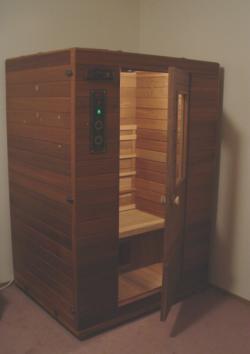
fig. 1 |
Okay, you accept that there may be health benefits of FIR sauna, but you've searched the internet and found that they are too expensive. I agree.
If there was an affordable way that you could get these same health benefits; Would you be interested? Keep reading, I'll show you how.
In 1998 I invested in a Healthmate FIR sauna (fig.1) to prove its benefit in helping people with CFS-FMS (Chronic Fatigue Syndrome - Fibromaylgia Syndrome), a condition that I've been studying since 1990. The sauna cost $3,000 plus another $300 for shipping.
The few people diagnosed with having CFS-FMS that proved the wellness program saw very good results reversing symptoms of the condition. These people share their experience in the "Feedback" section of this website.
The wellness program included regular use of FIR sauna, drinking alkaline ionized water, taking a few food supplements to provide for possible nutritional deficiencies, and probiotics to help restore beneficial bacteria to the gut. So far, only those people that have followed "ALL" parts of the wellness program have seen good results reversing symptoms of CFS-FMS.
Based on the good results seen by those that followed the wellness program, I concluded that FIR sauna is an important part of the program (as are the other parts of the program, especially drinking alkaline ionized water). But the FIR sauna was too expensive.
Many people afflicted with CFS-FMS have been financially devastated by years of medical expenses, some are no longer able to keep steady employment due to the condition; For these people, a FIR sauna costing thousands of dollars is not affordable. Others, who may live in an apartment or small house, may not have the floor space to allocate to a FIR sauna. I started looking for an alternative means to provide the health benefit of FIR sauna that was both effective and affordable.
The box type FIR sauna is just a big wood box with a door. The unique feature of this type sauna is the heating elements.
I found a manufacturer of infrared heaters and had them send different wattage heating elements for testing and evaluation. The goal was to find the right heating element that would produce a sauna environment similar to the box type FIR sauna that I had. After experimenting with several different elements I selected an element that produced a sauna environment in my bathroom similar to the sauna environment of the box type FIR sauna that I was using for comparison. I had the manufacturer custom build their product with this element. (Note: The standard FIR heater made by this manufacturer is too hot to use safely for sauna. You can get the heater described in this article from THMI.)
In this article I show how I use two free standing FIR heaters in the bathroom to create a FIR sauna environment similar to that in the expensive box FIR sauna. The cost using this method is about 1/10th the cost of a box sauna, about what it cost to ship the box sauna. An added benefit to using the free standing FIR heaters is that the heaters can be used to provide comfortable FIR heat to the living area of your home during the cold winter months.
The Room:
The bathroom pictured in these photos is an ideal size and shape, long and narrow. The room measures about 5 feet wide by 11 feet long. If your bathroom is not the ideal size and shape there are ways to modify the technique so that it will work.
The room that you use for sauna does not necessarily have to be the bathroom. One person found that the laundry room worked best for her. She would use the 2 FIR heaters for sauna while doing the laundry, she found that the heat from the dryer added nicely to the sauna environment. Another person reports using the FIR heaters in the kitchen. Another found that a partitioned section of a hallway worked well for her. One person even had her husband build an enclosure for her to use the FIR heaters (see details below). Any area that can be warmed up and allow for about a 5 to 6 foot separation of the FIR heaters will probably work well for a sauna room.
I find that the bathroom setting works best for me. You may wonder, If I own a box type sauna, why I use the FIR heaters in the bathrooms instead (I've not used the box sauna since 2001 when I started promoting the use of free standing FIR heaters). First, I think it important that I use the heaters to gain a better understanding of what others that are using two FIR heaters for sauna may experience. Second, the light in the box sauna is hard-wired to be on when operating. I prefer the darker environment and the seating position in the bathroom; I find it more relaxing. Also, If I need to use the toilet, I don't have to leave the warmth of the sauna and go to a cold room. And after the sauna, the tub/shower is conveniently right there.
Some people may be concerned that the heat may damage the room. No matter how long I let the room warm up it does not get hotter than about 120 degrees F. Not hot enough to cause any damage. The warm environment may even help to prevent the growth of molds by keeping the walls dry.
Electrical:
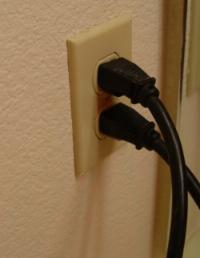
|
| fig. 2 |
The FIR heater described in this article (from THMI) has two 500 watt heating elements. With both elements operating, the heater draws 1000 watts and about 9 amps of current.
An electrical circuit rated for 20 amps can handle the load of the two heaters plugged in at the same time, fig. 2. Occasionally the GFI (ground fault interupt) breaker may trip but resetting the breaker usually solves the problem.
If the electrical circuit in your room cannot handle 20 amps, you may find it necessary to plug one heater into the bathroom outlet and use an extension cord to plug the second heater into a different electrical circuit. If you use an extension cord make sure that it is rated to safely handle the power requirements of the FIR heater.
If you have an older home and are not sure of the capacity of the house electrical wiring to safely handle the power requirements of two FIR heaters get the assistance of someone that is knowledgeable in this area.
In my bathroom I only have one electrical outlet, which I plug the two FIR heaters. I have added a heat lamp to the sauna configuration to add some light and near infrared energy to the environment. This requires another outlet. I use an extension cord plugged into an outlet on another electrical circuit in the house, in another room. In fig. 4 you can see the orange extension cord and the black power cord for the heat lamp; They are connected. By the way, there is no water in the tub and as a precaution when you are dealing with electrical equipment in the bathroom, keep the tub empty until after you are through doing the sauna and all devices are unplugged.
Warm-up:
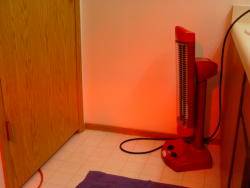
fig. 3 |
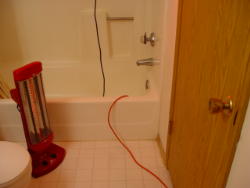
fig. 4 |
The air temperature does not get so hot that it will cause damage to the bathroom. When I use the heaters in my bathroom the air temperature rises to about 115 degrees F. in the hour or more that I allow the FIR heaters to warm the room.
During the warm-up, as a precaution, make sure that the FIR heaters are not positioned close to a wall such that it might start a fire. Also, make sure that there are no flammable materials near the heater, such as towels or shower curtain. The heaters are fairly safe to use, but common sense must be used.
As can be seen in fig. 3 and 4, during the warm up period, I position the two FIR heaters so that the FIR energy radiates onto a door. A wall, or any surface that will warm when the FIR rays are directed on it will probably work as well. Ceramic tile walls may not work as well since this material absorbs the energy and is slow to warm up. If the bathroom does not warm easily then adding a small heater designed to warm the air may solve the problem.
If the ambient air is not warm, a person can sit between the two FIR heaters and not get a good sweat and yet be very hot. The reason is that even though the FIR heaters heat the body, the FIR energy does not warm the air. The surrounding air is still cool, even though it can not be detected by the skin, which is being heated directly by the FIR energy.
The reason that the ambient air needs to be warm is that breathing cooler air, the lungs are able to cool the body. This cooling by the lungs precludes the body's need to produce a sweat to cool off.
I can put my face near a FIR heater (6 - 8 in. away) and my face will feel very warm. However, breathing in through the nose, the air is felt to be relatively cool in the nasal passage and mucous membrane does not dry out. If the air was hot it would have a noticeably different affect.
There are a couple areas in bathrooms which may require some adjustments to help warm the ambient air. Windows, exposed to cold outside air temperatures can dissipate heat from the air inside. If there are windows in the bathroom it may help to use a piece of cardboard or towel to cover the window.
Some bathrooms have ventilation fans in the room. Do not operate a fan while taking a sauna as this would cause a loss of warm air, making the environment less optimal for FIR sauna.
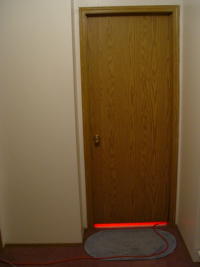
|
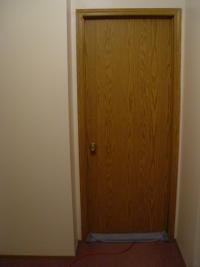
| |
| fig. 5 | fig. 6 |
In these photos you can see the extension cord that is used to supply more power to the room. As was mentioned earlier, this bathroom only has one electrical outlet which supplies power to the two FIR heaters. The extension cord provides power to the heat lamp which supplies near and middle infrared energy to the sauna environment. I highly suggest that everyone using FIR heaters for sauna give this configuration a try.
If you need to use an extension cord for anything make sure that it is rated correctly for the device or equipment that will be plugged into it.
Heat Lamp:
Some people promote the use of heat lamps for sauna, suggesting that they have the same benefit as FIR sauna. I do not doubt that heat lamp saunas do not provide benefits, but it is incorrect to suggest that heat lamps produce FIR energy. Heat lamps emit energy in the visible light spectrum and the near and middle infrared range. This energy is more for surface heating and does not have the penetration that FIR energy does. A very small amount of energy in the FIR range may be emitted by heat lamps but it is very small compared to the FIR energy produced by the FIR heater.
Adding a single heat lamp overhead does help to improve the sauna environment and adds some light to the area. I am not able to use the bathroom light because it automatically turns on the overhead room exhuast fan.
The light fixture that I use, fig. 7, is a standard clamp-on fixture that can be found at most hardware or building supply stores. The light is a standard red 250-watt heat lamp. Sylvania is one manufacturer of this type bulb. Sylvania also makes a white light heat lamp. I prefer the red lamp. The white light is too bright for my liking. However, if the white light were positioned behind you while saunaing, it would make for a better reading environment. I usually read while taking a sauna. The red lamp makes for a more meditative environment.
I clamp the fixture directly onto the shower curtain rod. As a safety measure I insert a small screw driver (other similar shaped objects will work as well) into the clamp above the shower curtain rod, fig. 8. This prevents the light fixture from possibly slipping off the rod.
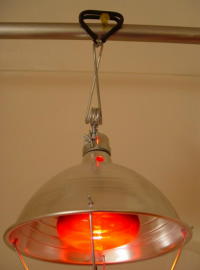
|
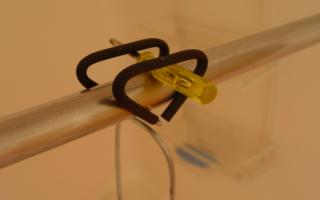
| |
| fig. 7 | fig. 8 |
Sauna Session:
In preparing for the sauna session I fill a 1/2 gallon pitcher with alkaline ionized water. During a 30 minute sauna session I will drink all of this water. I have recently been doing some experimenting with drinking water during the sauna session which I'll write about in another article. (During the hot bath that I usually take afterward I normally drink another quart of water.) If your just starting out, you will not be drinking this much water, but as you continue with regular sauna, and electrolyte levels increase, you will want to increase water intake during the sauna session. Most people with CFS-FMS are dealing with issues of dehydration. The body cannot perspire if it does not have water to release. Don't force yourself to sweat, it will eventually happen.
I take in two towels when I sauna; One to sit on, the other to dry with after the bath/shower after the sauna. Some medical professionals promoting the use of FIR sauna for detoxification suggest that a person wipe off perspiration during the sauna to prevent reabsorption of toxins. I do not bother with this but if you want to then an additional small towel may be needed for this purpose.
When the room has warmed up sufficiently, enter the room. Reposition the heaters such that they face each other and are about 5 or 6 feet apart. (see fig.9 and 10.) Place a towel on the floor between the two heaters. (In case it is not obvious, all clothing has been removed from the body). Sit down on the towel and enjoy the soothing warmth of the FIR heat.
I sit with my buttocks on the towel, knees raised, and feet slightly apart, on the floor. see fig. 11 Leaning forward slightly at the waist it is possible to rest the inside of the elbow over the top of the knees. I find that this helps to take some pressure off the lower back muscles while sitting up.
Some people that have difficulty sitting directly on the floor may find it easier to sit on a stool during the sauna session. A small wood stool would work well for this purpose; A stool without a back so that the FIR energy is not blocked from warming the body.
If sitting on the stool raises the torso much higher than the height of the FIR heaters you may find that standing the heaters on some kind of platform so that the FIR energy radiates primarily on the trunk of the body provides for a better sauna. The head of the heater can be rotated or tilted to direct the FIR energy to the area that you want heated.
Fig. 12 through 14 show what the sauna environment looks like using two FIR heaters and a single red heat lamp to create a FIR sauna environment in the bathroom. In fig. 11 you can see that when the heater elements are operating they emit very little visible light, when the room is dark you can see a faint orange glow from the elements, fig. 14.
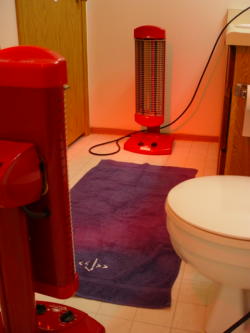
|
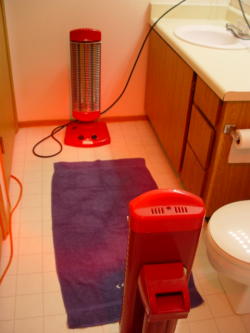
| |
| fig. 9 | fig. 10 |
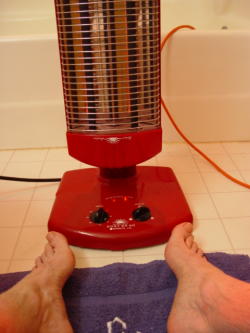
|
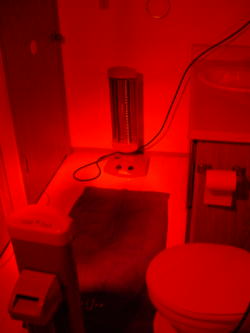
| |
| fig. 11 | fig. 12 |
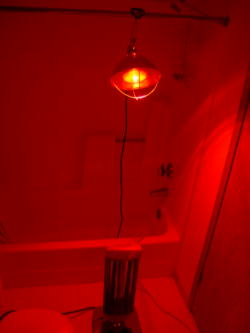
|
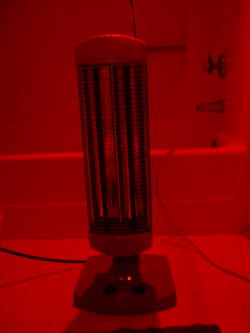
| |
| fig. 13 | fig. 14 |
Frequency of Use:
I use the bathroom for sauna 1X/week. Saturday morning is sauna time for me. Recently, experimenting with different electrolyte products, I have increased sauna frequency to 2X/week. I suggest that when starting the FIR program a person may sauna 2X/week for the first couple months and then decrease frequency to 1X/week. With the right electrolyte supplement a person can sauna 2X/week with little risk of becoming depleted of these salts by too frequent sauna use.
Conclusion:
There is a growing number of websites promoting the benefit of far infrared sauna, selling box saunas and dome devices. These saunas are nice but in my opinion they are too expensive for most of the people that need the health benefit to afford.
The FIR sauna is an important part of the wellness program that people have followed to find success reversing symptoms of CFS-FMS. However, alone, the FIR sauna did not provide success.
So far, the only people that have found good results reversing symptoms of CFS-FMS following the wellness program are those that also included alkaline ionized water in their program. Based on the results of a couple people it appears that this water helps to restore balance in the digestive system, primarily helping to restore production of HCl in the stomach.
The money that a person saves investing in the 2 FIR heater solution for sauna described in this article (the cost of 2 FIR heaters is about what I paid for shipping costs for the box sauna), they would be wise to invest in a water ionizer.
FIR sauna, alkaline ionized water, a few select food supplements for their high nutrition content of some key nutrients, and some added electrolytes make up the wellness program. All these items are available from THMI. ( For more information on these products you can email info@thmi.com )
I hope that this information has been helpful. I am grateful to all those that have helped, and are helping, to prove this approach to wellness. Each persons experience has helped in determining what is an essential part of the program, what may be needed less of, and in some cases not at al. Through your efforts I hope that one day a standard approach to reversing symptoms of CFS-FMS can be found.
All the best,
Jim
PS: To learn from the shared experiences from people following the FIR program, join the yahoogroup CFS-FMS_FIRST-Aid
|
|
For the handyman: Build your own Sauna Enclosure
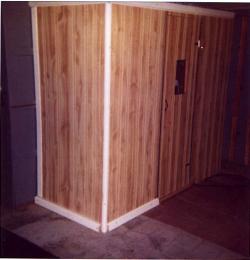
|
|
1. Mary's home-built sauna |
The enclosure shown here is one that Mary's husband built for her. He had some plywood that had been lying in his garage for a few years which he used. New plywood might not be a good choice for building a sauna enclosure as the resins used in making plywood may by irritating.
If you construct your own sauna enclosure, select a wood that has not been treated with resins. I think that pine would do a very good job. Also keep in mind that it is only the interior walls of the enclosure that is going to warm up.
The sauna enclosure is basically a wood box with a door. Mary's sauna enclosure measures 6 ft. wide X 3.5 ft. deep X 6 ft. high. A shelf, 15 inches above the floor, was built on the east and west side walls on which the FIR heaters stand.
It looks as good as any FIR sauna selling for a couple thousand dollars and is as functional. One advantage of the FIR heaters is that it can be used to provide warm FIR heat in the house during cold winter weather.
You can read Mary's success following the FIR program in the "Feedback" section of this website.
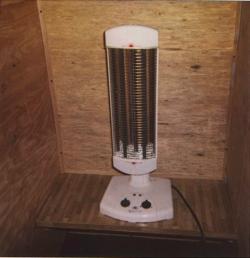
|
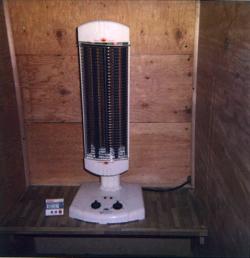
| |
| 2. Inside, East Wall | 3. Inside, West Wall |
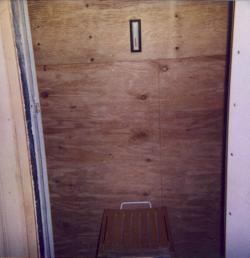
|
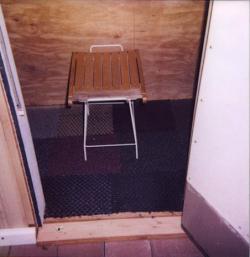
| |
| 4. Upper view through door way. | 5. Lower view through door way. |
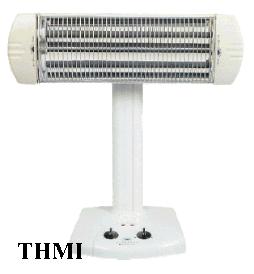
To learn about an affordable alternative means to obtaining the health benefits of the Far Infrared Sauna using two stand alone Far Infrared heaters,
email info@thmi.com for information.
All the benefits,
and more,
at a fraction of the cost.